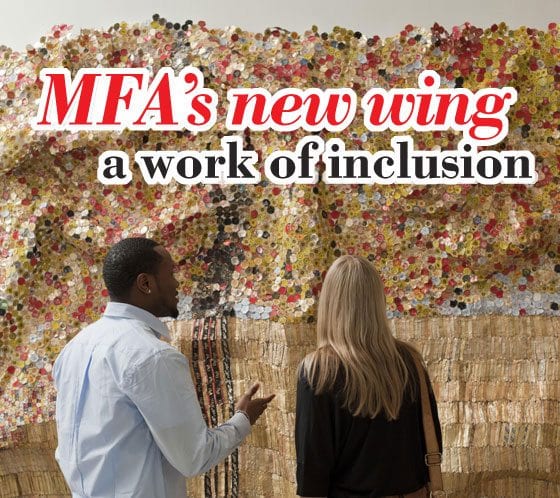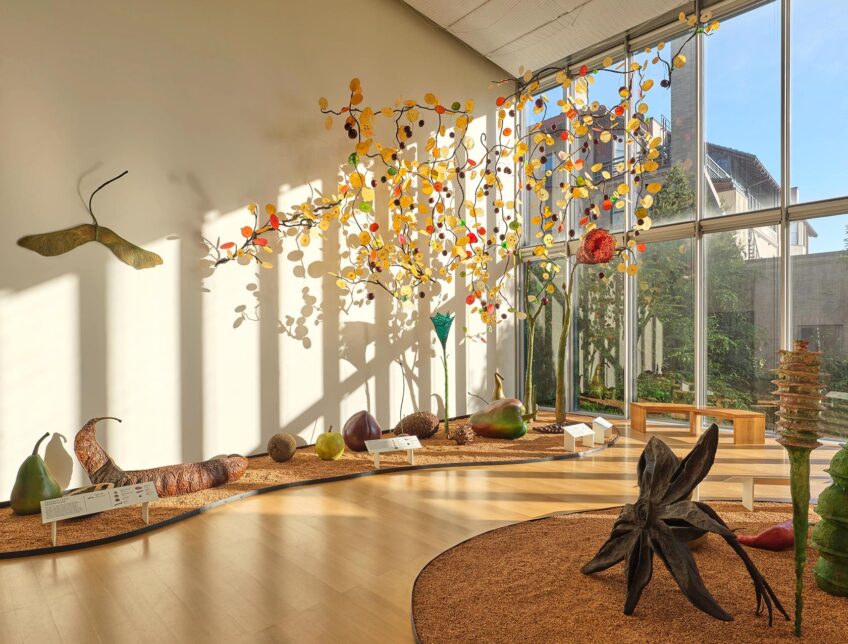The Musuem of Fine Arts recently unveiled its new expansion project that showcases art from the mid-50s.

The Musuem of Fine Arts recently unveiled its new expansion project that showcases art from the mid-50s.
A panoramic painting of a formal dinner party attended solely by African Americans rivets the eye in the first-floor gallery of the Linde Family Wing for Contemporary Art at the Museum of Fine Arts, Boston, which opened last weekend.
Their faces frozen in hauteur, the diners stare at us as if to say, “How dare you join our party?” In “Black Tie” (1981), African American Bostonian Robert T. Freeman renders the handsome woman in the foreground, who wears a white gown, with dashes of pigment, a technique John Singer Sargent uses in some of his society paintings. The blank-faced men behind her evoke the caricatures of German social satirist Max Beckmann.
Freeman, at last Thursday’s press opening, said that his painting reverses the feeling of exclusion from the middle class experienced by his parents’ generation, “the discomfort that an outsider feels.”
By mingling the works of established and lesser known artists, the debut exhibitions in the MFA’s new wing convey a welcoming inclusiveness. The latest milestone in the museum’s expansion, the two-floor renovation transforms the MFA’s west-facing section, designed by I.M. Pei and opened in 1981, into a showcase of art from the mid-50s onward.
One quarter of the wing’s more than 80,000 square feet of exhibition space includes two new galleries. Replacing the second-floor gift shop is the Daphne and Peter Farago Gallery, which displays craft and design works from the MFA’s Daphne Farago Collection. The Edward H. Linde Gallery on the first floor is dedicated to New England contemporary artists and alumni of the School of the Museum of Fine Arts.
Next to “Black Tie” are selections from the family chronicles of photographers Nicholas Nixon, of Cambridge, and Tina Barney, of Watch Hill, R.I., as well as a leafy reverie by painter Scott Prior. Near these familiar works is an arresting pair of photographs taken by Sharon Lockhart at Bath Iron Works in Maine. One is a still life of a lunch pail, Coke and sandwich. In the other, two shipyard workers sit on a palette having lunch. Each image is rendered with dignity and documentary clarity.
At the foot of the new staircase (alas, replacing the escalator) is a whimsical portrayal evoking the Holy Family, “Lo Desconocido (The Unknown)” (2011). Somerville artists Rául González III and his wife La Die insert themselves into an elaborate cartoon. He holds a rooster while striding alongside his wife, who in a sequined robe rides a mule cradling a baby.
Most of the 240 works on view are installed on the second floor of the wing, where the MFA’s former special exhibitions gallery has been renovated and subdivided into five display areas and a media screening room.
Organized loosely by theme, the exhibition mingles works by A-list elders and lesser-known artists. The exuberant mix of paintings, sculptures, photographs and works on paper is as much a celebration of the museum’s capacity to borrow as it is a showcase of its growing collection of contemporary art, which is not yet among the MFA’s strengths.
Curated with an eye for drama and sensuous immediacy, the show will reward return visits. Standouts include individual works as well as intriguing combinations. The delectably baroque, all-black “Iago’s Mirror” (2009) by African American artist Fred Wilson is mounted near a beaded curtain by Felix Gonzalez-Torres. Boldly geometric works dominate one gallery, including Ellsworth Kelly’s billboard-size primary color wall sculpture, a terrific highway image by Ed Ruscha and Andy Warhol’s “Red Disaster” (1963/1985), which duplicates the photo of an electric chair in a grid.
Known for self-portraits in an endless assortment of guises, Cindy Sherman is represented here by a photograph of herself in an oriental courtesan’s robe. Nearby is the startling “After Walker Evans” (1981), photographer Sherrie Levine’s portrait of herself as the gaunt woman in an iconic Depression-era image by Evans.
Palestinian Mona Hatoum’s “Grater Divide” (2002) turns a cheese grater into a razor-edged, 10-foot-high barrier. Nigerian El Anatsui’s “Black River” (2009) weaves discarded liquor bottle caps and foil wrappers into a glistening tapestry. A spectacular Donald Judd sculpture, “Untitled” (1993) stacks sleek Plexiglas rectangles into a column, each layer casting a prism of light.
The screening room shows three semi-playful studies of human endurance entitled “Dynamic Duration.” In Carlson/Strom’s “Sloss, Kerr, Rosenberg, and Moore”(2007), four lawyers enact a choreographed performance that mimics the gestures and speech of a high-test New York practice. In Kate Gilmore’s “Blood From a Stone” (2009), the artist, Sisyphus-like, endlessly lifts heavy white cubes onto a shelf. Floating upright in the Dead Sea, her feet clasping a watermelon, Israeli artist Sigalit Landau strokes her arms like fins to maintain her balance.
Turn from new media to the timeless medium of wood in the Henry and Lois Foster Gallery, where through March 4, “Ellsworth Kelly: Wood Sculpture” is on view. A 1948 graduate of the Museum School, Kelly distills observed phenomena — the contour of a hill or the slant of light on a page — into abstract forms. From 1958 to 1996, Kelly worked with renowned art fabricator Peter Carlson to translate his abstractions into 30 wood sculptures. Nineteen are on display here. Their simple forms and subtle joinery expose the eloquence of the wood’s grain and hue. A slender column of sapele has a grain that flows like the lines of a Chinese landscape scroll.
The MFA has now created a primary place for contemporary art within its encyclopedic breadth of collections, exhibitions and programs. With all of its resources, the museum can present contemporary artists in the context of their peers and predecessors. May the inclusive and adventurous spirit evident in the opening of the new wing inspire the exhibitions to come.






